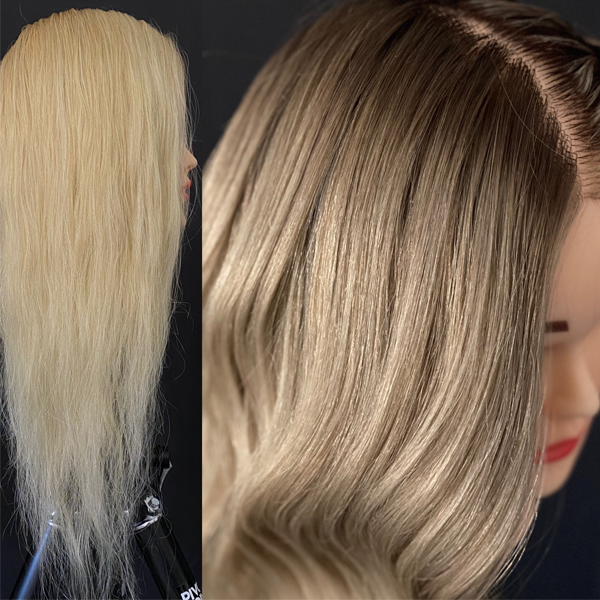Base Break & Tone In One Application? Here’s How!
3 Mistakes You’re Making With Permanent Color At The Shampoo Bowl
Breaking the base and toning at the same time with permanent color? That’s usually a HUGE no-no, but colorist Ashlee Norman (@ashleenormanhair) showed us how using Schwarzkopf Professional! Keep scrolling for her formulation and application tips to that will help you avoid unwanted lines of demarcation and hot roots on your clients.
Check out the finished look and grab the formulas below. Plus, watch the tutorial above to get all of Ashlee’s permanent color and gray blending tips!
CLICK HERE to purchase Schwarzkopf Professional tbh — true beautiful honest Permanent Hair Color from CosmoProf!
1. It starts with the formulation.
Permanent color isn’t the ideal choice as a gloss or toner, because it creates harsh lines or bands of tint when the client comes back for a retouch. So why use Schwarzkopf Professional tbh — true beautiful honest Permanent Hair Color to gloss and tone?
Easy! tbh is formulated with 50 percent less ammonia than the average permanent color for a translucent deposit. When combined with tbh — true beautiful honest Tone Softener you’re able to use it as a shadow root or to blend grays without creating harsh lines, hot roots or unwanted warmth.
Check Out The Finished Look & Tap The Beaker For The Formulas!


2. Change the developer depending on hair placement & type.
Another great way to avoid hot roots is to use a lower developer. Ashlee used 6-volume developer for the shadow root, so the natural base isn’t lifted visibly to avoid any unnatural warmth. In contrast, the mids and the ends were toned using 13-volume developer to break the base and create a natural fade from dark to light.
Pro Tip: When using this technique on clients with gray hair, up the developer to 20-volume to further open up the cuticle and get an even deposit. If the client is more than 75 percent gray, use a classic coverage technique without the Tone Softener instead.
3. Apply to wet hair versus dry.
This technique works best when applied to wet hair, because damp, towel-dried hair is more open at the cuticle than dry, dirty hair, so you get more coverage when applying color. Think of it like this: when you try to wipe up a spill with a dry sponge it’s harder than cleaning it up with a damp sponge because water attracts water.
Note: If your client has hair that tangles easily, apply conditioner or a treatment like Schwarzkopf Professional Fiber Clinix Treatment for Coarse Hair to the hair first, then rinse before applying color.
Products Used
More from
Schwarzkopf Professional®
-
Shampoos
Purple vs. Blue Shampoo: It’s More Than Color Theory, Here’s Why
-
Copper
Muted Bronze
-
Monthly Product Launch List
The Best Hair Launches Of March 2024
-
Hair Color
IGORA ZERO AMM Permanent Color
-
Celebrity
The Best Beauty Looks At The 2024 Oscars
-
Blonde
Sydney Sweeney’s Dark Suede Blonde
-
Celebrity
Schwarzkopf Professional® Launches Campaign Spearheaded By Chris Appleton & Sofia Vergara
-
Styling
OSiS® Upload
-
Celebrity
Sofia Vergara’s Red Carpet Glam Waves
-
BTC Hair Trend Report
Schwarzkopf Professional® Announces Chris Appleton As New Global Color Ambassador
-
Blonde
Virgin To Dimensional Blonde Blend
-
Monthly Product Launch List
11 New Game-Changing Hair Launches To Add To Your Arsenal
-
Blonde
The Biggest Hair Color Trends of 2024
-
BTC Hair Trend Report
The Biggest Haircut Trends of 2024
-
Brunette
Rich Beige Brunette
-
Celebrity
Paris Hilton’s Classic Blonde
-
Blonde
Dove Cameron’s Brunette-To-Blonde Color Correction
-
Celebrity
Sofia Vergara’s ’80s-Inspired Red Carpet Waves
-
Industry News
Sofia Vergara is Schwarzkopf Professional®’s New Global Brand Ambassador
-
Styling
OSiS+® Grip Mousse
-
Hairsprays
OSiS+® Freeze
-
Styling
OSiS+® Dust It
-
Brunette
Caramel Chocolate Brunette With Gray Coverage
-
Awards Shows
The Best Celebrity Hair Colors & Formulas From The 2024 Golden Globes





